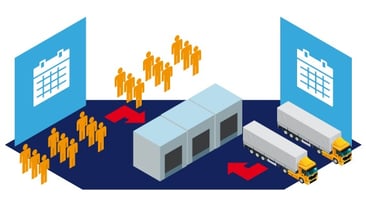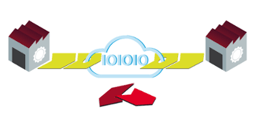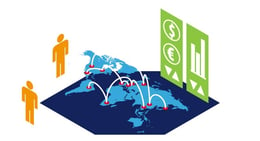On Getting the Most from Your Transport Logistics
Brian Hoey - May 10, 2018

 Let’s say you’re driving down a winding country road to some remote destination. At first, navigating is easy, but as the sun goes down and your headlights come on it becomes more and more difficult to make sure that you’re driving safely down the correct course. Eventually, night has fallen completely and your headlights provide the only illumination—you have to slow your driving speed, so that if an animal or other unexpected nocturnal being wanders into the path of your headlights you’ll have enough time to stop the car. If there’s stormy weather, the visibility becomes even more limited, and the possibility of an unexpected snafu increases.
Let’s say you’re driving down a winding country road to some remote destination. At first, navigating is easy, but as the sun goes down and your headlights come on it becomes more and more difficult to make sure that you’re driving safely down the correct course. Eventually, night has fallen completely and your headlights provide the only illumination—you have to slow your driving speed, so that if an animal or other unexpected nocturnal being wanders into the path of your headlights you’ll have enough time to stop the car. If there’s stormy weather, the visibility becomes even more limited, and the possibility of an unexpected snafu increases.
Though they are sometimes a necessity in order to get yourself to your destination on time, these are certainly neither the safest nor the most pleasant circumstances under which to drive. And yet, within the world of transport logistics, many businesses find themselves operating under precisely these conditions year after year. Sure, organizational visibility is not the same as visibility while driving, but the effects are much the same: processes slow down and become more susceptible to disruption, all because decision-making silos and poor data integration make an accurate view of the supply chain difficult to come by. The end result is that businesses struggle to get the most out of their transport logistics.
E2E Visibility
You can probably tell where we’re going with this. In order to truly maximize the added value of your logistics workflows and better integrate them into a more comprehensive value chain, it’s crucial to strive toward end-to-end (E2E) visibility. This can be accomplished by working towards increased digitization and taking steps to prevent the adoption of “Shadow IT,” i.e. IT systems that are not condoned by actual IT and operational stakeholders. In this way, planners within your organization can collaborate towards common goals, instead of working at cross purposes and creating inevitable disruptions down the line.
In terms of transportation management in particular, E2E visibility might manifest itself with transport planners gaining easier access to real-time routing information, inventory and capacity management systems, information about production processes, delivery windows, and other mission critical data with the power to make their plans more agile and adaptable. In this way, companies can build in the flexibility necessary to overcome disruptions and better preserve on-time deliveries even in the face of unforeseen weather events or vehicle breakdowns.
S&OE
Among the benefits of increased visibility when it comes to transportation planning is that the integration of real-time supply stream information can enable planners to turn mid-term operational plans into actionable daily and weekly workflows. This process, which has recently emerged as a key component of Industry 4.0, is so powerful that it has been given its own designation: sales & operations execution (S&OE). By monitoring daily and weekly changes in demand and other disruptions, S&OE helps to prevent breakdowns and make small, ongoing adjustments to various value chain processes.
How does this help your business get the most out its transport logistics? Simply put, S&OE enables you to dynamically reroute and reschedule transport usage to reflect changing conditions. In the past, mid-term transportation plans would likely be disrupted long before their monthly or quarterly planning period was over. With S&OE, planners can work to prevent plans from getting off track by utilizing hubs, gates, and other transport network elements in a way that reflects the changing nature of customer restrictions and various supply chain events. Specifically, S&OE can facilitate optimized, dynamic decision-making in a variety of situations:
- If a production slowdown leads to a shortage of certain parts, planners can use real-time capacity information to determine whether to use a less-than-full truckload or delay a particular truck.
- Planners can reroute freight through different hubs depending on real-time weather and traffic patterns.
- Businesses can make more informed inventory and warehouse usage decisions based on the daily or weekly demand and execution snapshot that S&OE provides.
Advanced Analytics
S&OE is already taking transport logistics workflows distinctly into the realm of Industry 4.0, but as the technological advances of the so-called “fourth industrial revolution” drive an increasingly connected, data-driven vision of manufacturing, shipping, and logistics, transport logistics in particular will become subject to increased automation and ever-smarter workflows. For instance, some companies are already integrating advanced analytics into their transport processes, enabling them to create more accurate demand forecasts and harvest prescriptive insights about the best possible network arrangements and routing options. Like S&OE, this process will require a high degree of visibility, but the reward will be a smarter, more agile system overall.
LATEST POSTS
- Understand Circular Economy in The Manufacturing Industry
- How Can Industry 4.0 IT Integration Be Achieved Smoothly?
- The Significance of Order Sequencing in Discrete Manufacturing
- How to improve your Supply Chain Management: The Power of Control Towers
- Optimizing Human Resource Scheduling in Manufacturing: A Technological Approach



